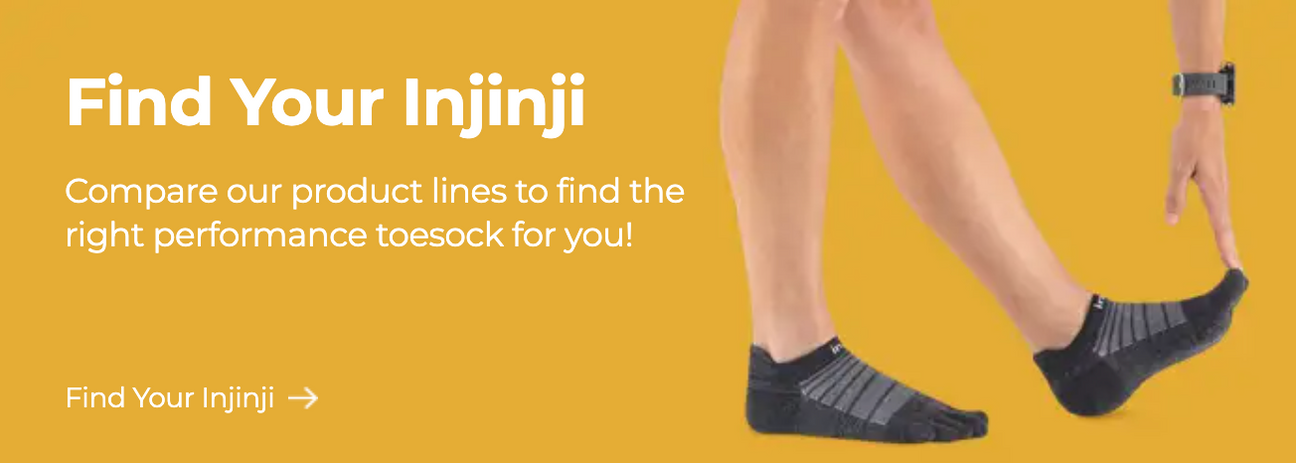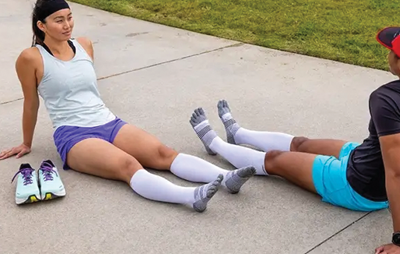Running cadence plays a crucial role in running performance, yet many runners find it challenging to grasp. Understanding and optimising running cadence can help you improve your speed, endurance, and injury prevention.
Physical therapist, marathoner, and Team Injinji Athlete Francesca Petrey breaks down the concept of cadence and provides insight on how it can enhance your running efficiency and overall experience.
What Is Cadence?
Francesca defines running cadence as “a common running parameter used to measure the speed at which you can turn your legs over while running.”
“It is measured in steps per minute. On average, a runner’s cadence is approximately 180 steps/min; however, this number fluctuates based on the individual and the training/running goal. It's common for those new to running to have a lower cadence. The good news is that cadence can be increased with the right training approach.”

How to Measure Running Cadence
Measuring cadence might be easier than you think! Francesca explains that “running cadence is typically measured by counting the number of steps a runner takes in one minute, known as "steps per minute" (spm).”
There are a few simple techniques to determine your average cadence. “Cadence can be tracked manually by counting steps per sixty seconds, or by using fitness trackers or smartwatches with built-in cadence monitoring. Most modern devices automatically measure cadence using sensors that track foot strikes, offering real-time feedback to the runner.”
Every runner is different, and there is not a ‘one-size-fits-all’ approach to determining the ideal cadence. It depends on a runner’s height, leg length, and running experience.

Why Cadence Matters
It’s important to understand what cadence is, and how it can be used in training.
“Cadence influences running efficiency and can help reduce the risk of injury,” Francesca explains. “A higher cadence, generally around 170-180 steps per minute, encourages shorter, quicker strides, which can lower the impact on the body. Monitoring and adjusting cadence can also improve performance by optimising energy use and promoting a more fluid and efficient running form.”
Tips for Improving Cadence
If you have ever tried running at a faster cadence than your body is used to, you might think it feels a bit strange at first. It can take some time for your body to adjust.
Francesca’s tips for improving your running cadence:
- Focus on gradually increasing your steps per minute by 5-10% per week to avoid injury.
- Work on shortening your stride length, aiming for quicker, lighter steps that reduce heel striking and excessive braking force. Instead of landing on the heel, focus on a quick foot turnover by aiming to land on the midfoot, then push off with your toes.
- Incorporating drills such as high knees, fast feet, or using a metronome can also help develop a consistent and efficient cadence.
 |
 |
| High knee drills should focus on a high cadence and short steps. Keep your core engaged and focus on bringing your knees up smoothly to your chest. | Fast feet drills prioritise quick, light steps on the balls of your feet, focusing on speed of steps rather than knee height. |
Not sure where to start? Francesca explains that “the easiest way to work on this is to use a metronome app or listen to music that has a beats-per-minute (bpm) that matches your goal spm.”
“For example: If you are trying to increase your cadence baseline (140 spm) by 10%, you will find a playlist with music at 154 bpm and follow the beat with your foot strike. You can use apps attached to your running watch to track your cadence after the run to see how it worked. If that increase is too difficult, begin with 5% increases in your cadence. Increase your cadence by 5-10% every week, or every other week, until you meet your goal.”
_____
Improving your cadence is a journey that can lead to more enjoyable and injury-free runs. With the right training – and the comfort of Injinji toesocks! - you’ll be ready to take each stride with confidence and ease.





